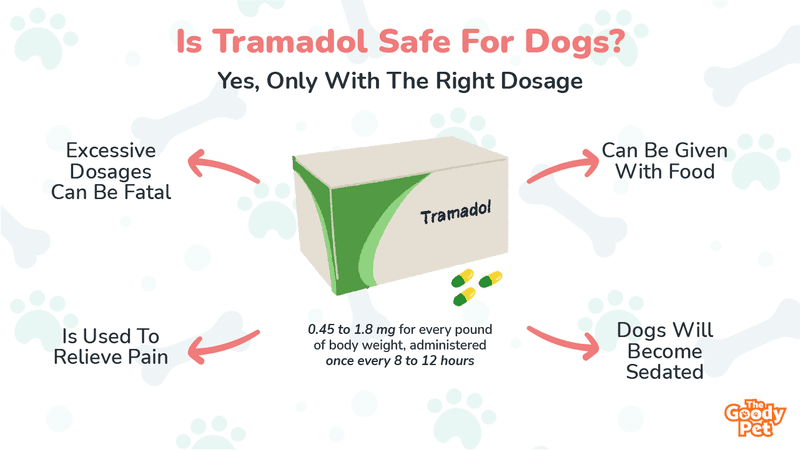Whenever you’re in pain, taking Tramadol can help relieve the pain, and if your dog is going through a similar problem, you could be tempted to give them Tramadol. However, vets advise against doing this without a prescription.
So, is Tramadol safe for dogs? Tramadol is totally safe for dogs when administered in the right dosage. In excessive dosages, however, Tramadol can kill a dog. Tramadol works by inhibiting the brain’s ability to take up serotonin and norepinephrine.
If your dog has some condition that is putting them in pain and you’re considering giving them Tramadol, this article is for you. In a bit, we will discuss what Tramadol does for dogs, how to administer Tramadol to your dog, some of the side effects of Tramadol, as well as the difference between Tramadol meant for human use and Tramadol for dogs. Before that, however, let’s look at how often you can give Tramadol to your dog.
How Often Can You Give A Dog Tramadol?
The recommended Tramadol dosage for dogs is 0.45 to 1.8 mg for every pound of body weight. This should be administered once every 8 to 12 hours, or 6 hours if your dog has cancer. So, how much Tramadol can you give your dog weighing at least 50 lbs?
A 50-pound dog can take anywhere between 22.5 to 90 mg of Tramadol every 8 to 12 hours.
The proper dosage will also depend on other factors, including the dog’s health and the condition they’re suffering from. This is why it is recommended that Tramadol only be given following a vet’s advice.
How Is Tramadol Administered?
Tramadol is administered orally. It can be administered in the form of a capsule, as a tablet, or as a compounded liquid. If you’re giving Tramadol in tablet form, avoid crushing the tablet before administering.
Tramadol can be given together with food or separately. However, because of the bitter taste, it is more advisable to give the drug together with food. After administering Tramadol, you should also provide your pooch with plenty of drinking water.
If you’re administering Tramadol in liquid form, you should be very careful when measuring out the required dosage, since an overdose can easily become fatal.
How Long Does It Take For Tramadol To Kick In?
Tramadol is a fast acting drug. Your dog will start feeling better within 1 to 2 hours of administering the drug. However, if your dog is experiencing chronic pain, they may have to take the drug for a couple of weeks before you can see the full effects.
It’s also good to note that dogs who have chronic pain and have been taking Tramadol for a long time can build up a tolerance against the drug. In such cases, your vet can prescribe a combination of Tramadol and other pain killers.

What Does Tramadol Do For Dogs?
Tramadol is an opioid, or a narcotic pain killer. Unlike other kinds of painkillers, which deal with the underlying issue causing the pain, opioids work by binding to the opioid receptors in your dog’s brain and spinal cord.
By doing so, it limits the ability of your dog’s brain to take up serotonin and norepinephrine, thus tricking your dog’s brain into believing that they are not in pain.
Since it does not deal with the underlying issue, Tramadol is usually prescribed together with other nonsteroidal anti-inflammatory drugs (NSAIDs) that will help treat the underlying condition.
Will Tramadol Hurt My Dog?
Even though it blocks the opioid receptors in your dog’s brain and spinal cord, Tramadol is not bad for your dog as long as you give the drug in the correct dosages.
However, if you give excessive dosages of Tramadol to your dog, this can result in some very serious side effects that could even be fatal for your pooch.
What Does Tramadol Treat?
Tramadol is used to treat various conditions that cause acute pain for dogs. It can be given for physical injuries, after surgery or other kinds of invasive medical procedures, as well as for lameness, coughing, and so on.
Tramadol is also good for dogs with arthritis, as well as any other conditions that cause chronic pain, including cancer, non-surgical intervertebral disc disease, and canine degenerative myelopathy.
By inhibiting the brain’s ability to take up serotonin and norepinephrine, Tramadol creates a high level of these chemicals in your dog’s bloodstream, which can put your dog in a euphoric state. As a result, Tramadol is sometimes used to treat anxiety and depression in dogs.
Despite its huge benefits, administration of Tramadol can also cause some unwanted side effects, which we will look at in the next section.

What Are The Bad Side Effects Of Tramadol?
Even when given in correct dosages, Tramadol can sometimes cause negative side effects in dogs. Due to Tramadol’s inhibition of the opioid receptors, most dogs will become sedated after taking Tramadol. This should not be a cause of concern.
Some of the other symptoms, however, are more serious, and if they persist, you should talk to your vet about alternative forms of treatment.
Some of the serious side effects of Tramadol that you should keep your eye out for include:
- Diarrhea
- Nausea and vomiting
- Dizziness
- Constipation and stomach upsets
- Loss of appetite
If you notice any of these symptoms, continue observing your four-legged buddy and get in touch with a vet if the symptoms get worse.
In case of a Tramadol overdose, your dog will exhibit the following symptoms.
- Reduced heart rate
- Breathing difficulties (Tramadol can make your dog pant)
- Lethargy
- Dizziness
- Shaking and tremors
- Seizures
- Uncontrollable movement (ataxia)
- Blurred vision
- Dilated pupils
- Loss of consciousness
These are life-threatening symptoms, and if your dog starts exhibiting any of these symptoms a few hours after administering Tramadol, you should call your vet immediately.
As with most other medications, there is also the risk that your canine buddy could develop an allergic reaction to Tramadol. In severe cases, this can result in anaphylaxis, which can lead to death.
Therefore, after administering Tramadol to your dog, you need to observe them closely, watching out for signs of an allergic reaction. Some of these signs include coughing, sneezing, and other breathing difficulties, hives, swelling, and so on. If you notice any of these signs, you should get in touch with your vet immediately.
Finally, you should let your vet know if your furry buddy has been diagnosed with some other medical conditions, if they are taking other medications, or if your dog is pregnant since Tramadol can make some of these conditions worse.

What Is The Difference Between Tramadol For Humans And Dogs?
Most medications given to both humans and canines usually have some differences in their chemical compositions. However, Tramadol for canines has the exact same chemical composition as Tramadol for humans.
The difference between dog Tramadol and human Tramadol is the amount or dosage required for each. This means that Tramadol 50 mg is the same for both humans and canines.
Despite being essentially the same, it is still not advisable to give your canine buddy human Tramadol even if you have it lying somewhere in the house. If your dog is in pain and you have some human Tramadol that you think can help relieve their pain, talk to your vet first before administering it to your four-legged buddy.
Can You Give A Dog Human Painkillers?
When your dog is in pain, it can be very tempting to give them human painkillers to ease their pain. However, aside from Tramadol, very few human painkillers are safe to give to dogs.
Most over-the-counter human painkillers like aspirin, naproxen, and ibuprofen are all categorized as non-steroidal anti-inflammatory drugs (NSAIDs). Most NSAIDs work by inhibiting cyclooxygenase, which is responsible for producing prostaglandins. Pain, fever and inflammation are caused by prostaglandins as part of the healing process.
While prostaglandins cause pain, they also have other important roles, including making it possible for blood to clot, ensuring enough flow of blood to the kidneys, and triggering the production of mucus within the GI tract.
Giving your dog human painkillers can adversely affect the function of your dog’s prostaglandins, leading to conditions like kidney dysfunction, loss of appetite, bloody diarrhea and vomiting, liver damage, and gastrointestinal ulcers.
If your dog is in pain, the best thing to do is to consult your vet and have them prescribe painkillers that are safe for dogs.

Related Questions
How Do You Know When It’s Time To Let Your Dog Go? If your dog is going through a lot of pain and suffering from a chronic condition that has no cure or treatment, it is time to let them go. So, how do you know when a dog is in pain? Dogs in serious pain will show symptoms like loss of appetite, antisocial behavior, whimpering, mobility difficulties, and so on.
How Much Does Euthanizing A Dog Cost? The cost of euthanizing and cremating your dog can range anywhere between $50 and $300, depending on your dog’s weight, and the vet putting your dog to sleep. You should also expect other costs, such as the cost of examination before euthanizing, the cost of cremation, and so on.
What Pain Killers Can You Give Dogs? The best painkiller for dogs is carprofen (Rimadyl or Novox). Other suitable painkillers for dogs include meloxicam (Metacam), firocoxib (Previcox), and deracoxib (Deramaxx). But before giving them to your pooch, it is always best to first consult your vet.





